新概念一重点知识点归纳
- 格式:docx
- 大小:19.70 KB
- 文档页数:8
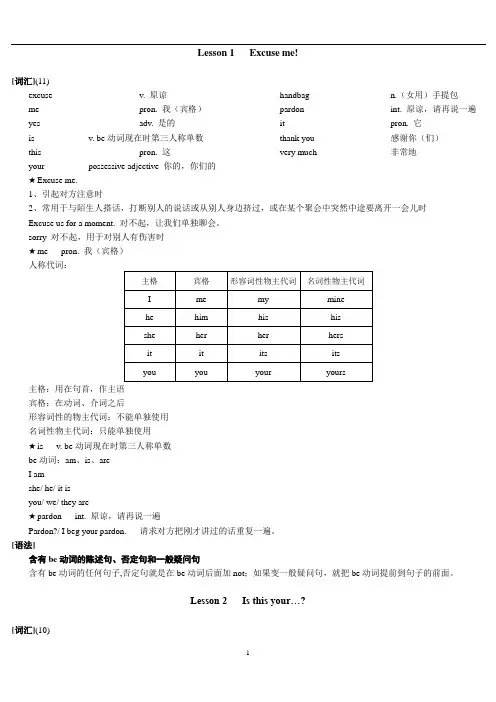
Lesson 1 Excuse me! [词汇](11)excuse v. 原谅me pron. 我(宾格)yes adv. 是的is v. be动词现在时第三人称单数this pron. 这your possessive adjective 你的,你们的handbag n.(女用)手提包pardon int. 原谅,请再说一遍it pron. 它thank you 感谢你(们)very much 非常地★Excuse me.1、引起对方注意时2、常用于与陌生人搭话,打断别人的说话或从别人身边挤过,或在某个聚会中突然中途要离开一会儿时Excuse us for a moment. 对不起,让我们单独聊会。
sorry 对不起,用于对别人有伤害时★me pron. 我(宾格)人称代词:主格:用在句首,作主语宾格:在动词、介词之后形容词性的物主代词:不能单独使用名词性物主代词:只能单独使用★is v. be动词现在时第三人称单数be动词:am、is、areI amshe/ he/ it isyou/ we/ they are★pardon int. 原谅,请再说一遍Pardon?/ I beg your pardon. 请求对方把刚才讲过的话重复一遍。
[语法]含有be动词的陈述句、否定句和一般疑问句含有be动词的任何句子,否定句就是在be动词后面加not;如果变一般疑问句,就把be动词提前到句子的前面。
Lesson 2 Is this your…?[词汇](10)pen n.钢笔pencil n.铅笔book n.书watch n.手表coat n.上衣,外衣dress n.连衣裙skirt n.裙子shirt n.衬衣car n.小汽车house n.房子★dress① n. 连衣裙;套裙② n. 服装,衣服casual dress 便服evening dress 晚礼服★house n.房子house 房子,一般指独立的院落,更具体的指房子的建筑,结构family 侧重家庭的成员There are four people in my family. 在我家里有四口人。
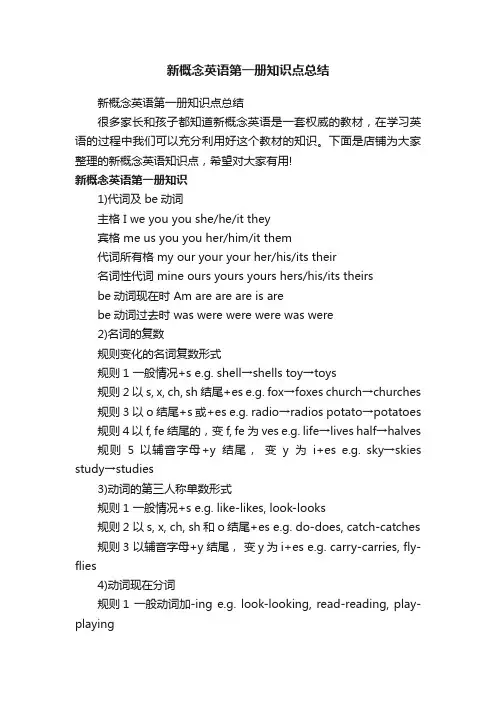
新概念英语第一册知识点总结新概念英语第一册知识点总结很多家长和孩子都知道新概念英语是一套权威的教材,在学习英语的过程中我们可以充分利用好这个教材的知识。
下面是店铺为大家整理的新概念英语知识点,希望对大家有用!新概念英语第一册知识1)代词及be动词主格 I we you you she/he/it they宾格 me us you you her/him/it them代词所有格 my our your your her/his/its their名词性代词 mine ours yours yours hers/his/its theirsbe动词现在时 Am are are are is arebe动词过去时 was were were were was were2)名词的复数规则变化的名词复数形式规则1 一般情况+s e.g. shell→shells toy→toys规则2 以s, x, ch, sh结尾+es e.g. fox→foxes church→churches 规则3 以o结尾+s或+es e.g. radio→radios potato→potatoes 规则4 以f, fe结尾的,变f, fe为ves e.g. life→lives half→halves 规则5 以辅音字母+y结尾,变y为i+es e.g. sky→skies study→studies3)动词的第三人称单数形式规则1 一般情况+s e.g. like-likes, look-looks规则2 以s, x, ch, sh和o结尾+es e.g. do-does, catch-catches 规则3 以辅音字母+y结尾,变y为i+es e.g. carry-carries, fly-flies4)动词现在分词规则1 一般动词加-ing e.g. look-looking, read-reading, play-playing规则2 以不发音的字母结尾的单词去e加-ing e.g. make-making, take-taking, arrive-arriving规则3 重读闭音节词结尾,即单词中只有一个元音字母,其后紧跟一个辅音字母的词,双写辅音字母再加-ing e. g. run-running, sit-sitting, get-getting, swim-swimming, stop-stopping5)动词过去式规则动词变化规则1 一般动词加-ed e.g. look-looked, watch-watched, play-played规则2 以e结尾的加-d e.g. make-maked, arrive-arrived规则3 以辅音字母y结尾的变y为i加-ed cry-cried, carry-carried 规则4 重读闭音节词结尾,即单词中只有一个元音字母,其后紧跟一个辅音字母的词,双写辅音字母再加-ed stop-stopped 过去式的读音在清辅音后面(除外)读/t/ e.g. walked, jumped在浊辅音和元音后读/d/ e.g. washed, watched在/t/,/d/后读/id/ e.g. waited, hated新概念英语基础知识点1.in+语言/颜色/衣帽等,表示使用某种语言或穿着……。
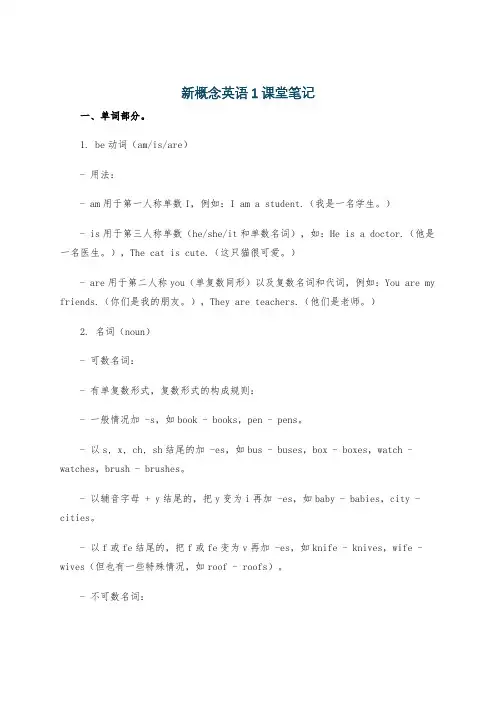
新概念英语1课堂笔记一、单词部分。
1. be动词(am/is/are)- 用法:- am用于第一人称单数I,例如:I am a student.(我是一名学生。
)- is用于第三人称单数(he/she/it和单数名词),如:He is a doctor.(他是一名医生。
),The cat is cute.(这只猫很可爱。
)- are用于第二人称you(单复数同形)以及复数名词和代词,例如:You are my friends.(你们是我的朋友。
),They are teachers.(他们是老师。
)2. 名词(noun)- 可数名词:- 有单复数形式,复数形式的构成规则:- 一般情况加 -s,如book - books,pen - pens。
- 以s, x, ch, sh结尾的加 -es,如bus - buses,box - boxes,watch - watches,brush - brushes。
- 以辅音字母 + y结尾的,把y变为i再加 -es,如baby - babies,city - cities。
- 以f或fe结尾的,把f或fe变为v再加 -es,如knife - knives,wife - wives(但也有一些特殊情况,如roof - roofs)。
- 不可数名词:- 没有复数形式,例如water(水),milk(牛奶),bread(面包)等。
在表示数量时,要用相应的量词词组,如a glass of water(一杯水),a piece of bread (一片面包)。
3. 形容词(adjective)- 用法:用来修饰名词,说明事物或人的特征。
例如:a beautiful flower(一朵美丽的花朵),a tall boy(一个高个子男孩)。
- 形容词的位置:一般放在名词前面,但在某些结构中也可以后置,如something interesting(一些有趣的东西)。
4. 代词(pronoun)- 人称代词:- 主格:I(我),you(你/你们),he(他),she(她),it(它),we(我们),they(他们/她们/它们)。
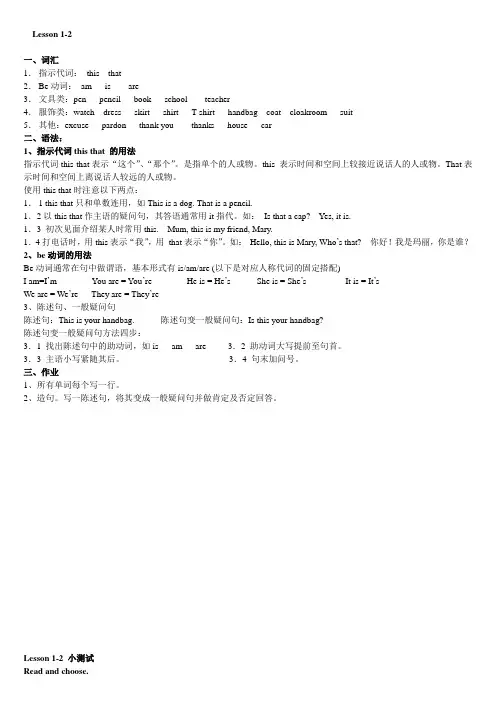
Lesson 1-2一、词汇1.指示代词:this that2.Be动词:am is are3.文具类:pen pencil book school teacher4.服饰类:watch dress skirt shirt T-shirt handbag coat cloakroom suit5.其他:excuse pardon thank you thanks house car二、语法:1、指示代词this that 的用法指示代词this that表示“这个”、“那个”。
是指单个的人或物。
this 表示时间和空间上较接近说话人的人或物。
That表示时间和空间上离说话人较远的人或物。
使用this that时注意以下两点:1.1 this that只和单数连用,如This is a dog. That is a pencil.1.2以this that作主语的疑问句,其答语通常用it指代。
如:Is that a cap? Yes, it is.1.3 初次见面介绍某人时常用this. Mum, this is my friend, Mary.1.4打电话时,用this表示“我”,用that表示“你”。
如:Hello, this is Mary, Who’s that? 你好!我是玛丽,你是谁?2、be动词的用法Be动词通常在句中做谓语,基本形式有is/am/are (以下是对应人称代词的固定搭配)I am=I’m You are = You’re He is = He’s She is = She’s It is = It’sWe are = We’re They are = They’re3、陈述句、一般疑问句陈述句:This is your handbag. 陈述句变一般疑问句:Is this your handbag?陈述句变一般疑问句方法四步:3.1 找出陈述句中的助动词,如is am are 3.2 助动词大写提前至句首。
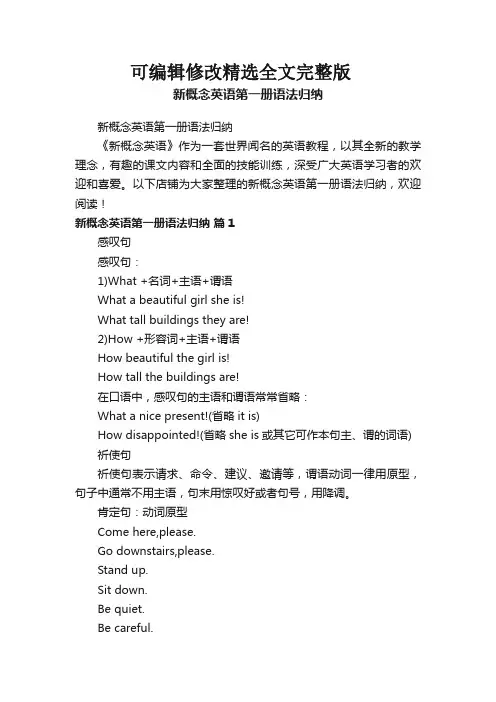
可编辑修改精选全文完整版新概念英语第一册语法归纳新概念英语第一册语法归纳《新概念英语》作为一套世界闻名的英语教程,以其全新的教学理念,有趣的课文内容和全面的技能训练,深受广大英语学习者的欢迎和喜爱。
以下店铺为大家整理的新概念英语第一册语法归纳,欢迎阅读!新概念英语第一册语法归纳篇1感叹句感叹句:1)What +名词+主语+谓语What a beautiful girl she is!What tall buildings they are!2)How +形容词+主语+谓语How beautiful the girl is!How tall the buildings are!在口语中,感叹句的主语和谓语常常省略:What a nice present!(省略it is)How disappointed!(省略she is或其它可作本句主、谓的词语) 祈使句祈使句表示请求、命令、建议、邀请等,谓语动词一律用原型,句子中通常不用主语,句末用惊叹好或者句号,用降调。
肯定句:动词原型Come here,please.Go downstairs,please.Stand up.Sit down.Be quiet.Be careful.祈使句中如果有唤语,一定要用逗号隔开,放在句首或者句尾:Come in,Amy.Sit down here,Tom.Mary,give me a book please.否定:Don't+动词原型Don't come here.Don't sit down.Don't stand up.Don't give me it.let sb. do 让某人做Let me pass.Let us have a rest.Let's have a rest.反意疑问:Let's have a walk along the river,shall we?Let us go out for a drink,will you?so/neither的倒装倒装句:so/neither的倒装eg: He can swim. So can I.She didn't go to class. Neither did I.结构:so/neither+be+ 主语so/neither+助动词+ 主语so/neither+情态动词+ 主语助动词:一般现在时: do,does/am,is,are现在进行时: am,is,are一般过去时: did现在完成时: have,has一般将来时: will,shall过去进行时: was,were过去完成时: had过去将来时: would直接引语/间接引语如果引语的主句所用动词为过去时,那么间接引语要做相应变化:时态,人称,时间地点及指示词1)时态变化:一般现在时——一般过去时现在进行时——过去进行时一般过去时——过去完成时现在完成时——过去完成时一般将来时——过去将来时be going to——was/were going to/wouldcan--couldmay--might2)时间地点及指示词的变化:here-there,tomorrow-the next day,the following day,this-that…3)人称变化:根据句意改变人称。
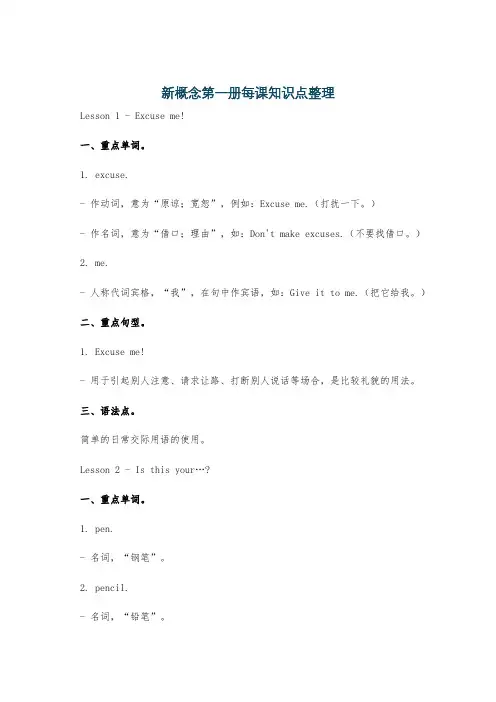
新概念第一册每课知识点整理Lesson 1 - Excuse me!一、重点单词。
1. excuse.- 作动词,意为“原谅;宽恕”,例如:Excuse me.(打扰一下。
)- 作名词,意为“借口;理由”,如:Don't make excuses.(不要找借口。
)2. me.- 人称代词宾格,“我”,在句中作宾语,如:Give it to me.(把它给我。
)二、重点句型。
1. Excuse me!- 用于引起别人注意、请求让路、打断别人说话等场合,是比较礼貌的用法。
三、语法点。
简单的日常交际用语的使用。
Lesson 2 - Is this your…?一、重点单词。
1. pen.- 名词,“钢笔”。
2. pencil.- 名词,“铅笔”。
3. book.- 名词,“书”。
4. watch.- 名词,“手表”;也可作动词,“观看”,如:watch TV(看电视)。
二、重点句型。
1. Is this your pen?- 这是一般疑问句,其结构为“be动词(is/are等)+主语+其他”,回答可以是“Yes, it is.”或者“No, it isn't.”三、语法点。
1. 一般疑问句的构成与回答。
2. 指示代词this的用法,用来指代离说话者较近的人或物。
Lesson 3 - Sorry, sir.一、重点单词。
1. umbrella.- 名词,“雨伞”。
2. please.- 副词,用于请求别人做某事时表示礼貌,如:Please open the window.(请打开窗户。
)二、重点句型。
1. Is this your umbrella?- 同Lesson 2中的一般疑问句结构。
2. Sorry, sir.- “sorry”表示歉意,“sir”是对男性的尊称。
三、语法点。
1. 继续巩固一般疑问句。
2. 尊称“sir”的用法。
Lesson 4 - Is this your…?一、重点单词。
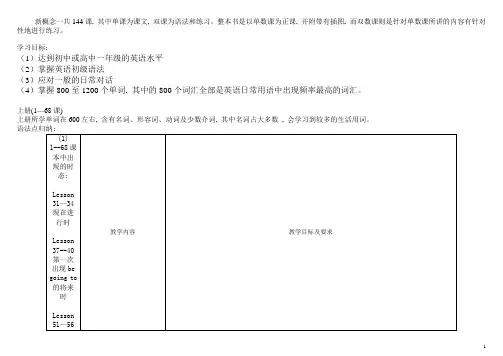
新概念一共144课, 其中单课为课文, 双课为语法和练习。
整本书是以单数课为正课, 并附带有插图, 而双数课则是针对单数课所讲的内容有针对性地进行练习。
学习目标:
(1)达到初中或高中一年级的英语水平
(2)掌握英语初级语法
(3)应对一般的日常对话
(4)掌握800至1200个单词, 其中的800个词汇全部是英语日常用语中出现频率最高的词汇。
上册(1—68课)
上册所学单词在600左右, 含有名词、形容词、动词及少数介词, 其中名词占大多数, 会学习到较多的生活用词。
中册(69—106课), 大约有300单词, 包含名词、动词、形容词、副词、介词, 其中所学的动词和副词会有所增加。
课文中出现的时态有:
Lesson 67—76 为一般过去式
Lesson 83—90 为现在完成时
Lesson 91—96 为一般将来时
下册(107—144课), 大约有300个单词
1、语法点归纳:
2、L107-108形容词的比较级, 最高级
3、L117-118时间状语从句和过去进行时
4、L121-122定语从句
5、L119-120 过去完成时
6、L139-140宾语从句
7、L141-144被动语态。
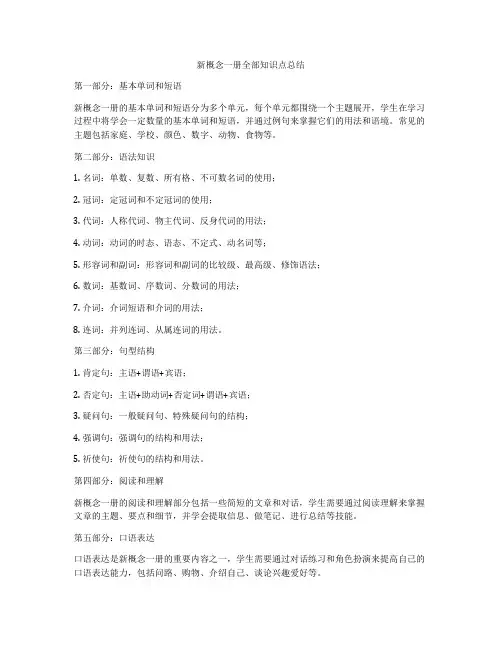
新概念一册全部知识点总结第一部分:基本单词和短语新概念一册的基本单词和短语分为多个单元,每个单元都围绕一个主题展开,学生在学习过程中将学会一定数量的基本单词和短语,并通过例句来掌握它们的用法和语境。
常见的主题包括家庭、学校、颜色、数字、动物、食物等。
第二部分:语法知识1. 名词:单数、复数、所有格、不可数名词的使用;2. 冠词:定冠词和不定冠词的使用;3. 代词:人称代词、物主代词、反身代词的用法;4. 动词:动词的时态、语态、不定式、动名词等;5. 形容词和副词:形容词和副词的比较级、最高级、修饰语法;6. 数词:基数词、序数词、分数词的用法;7. 介词:介词短语和介词的用法;8. 连词:并列连词、从属连词的用法。
第三部分:句型结构1. 肯定句:主语+谓语+宾语;2. 否定句:主语+助动词+否定词+谓语+宾语;3. 疑问句:一般疑问句、特殊疑问句的结构;4. 强调句:强调句的结构和用法;5. 祈使句:祈使句的结构和用法。
第四部分:阅读和理解新概念一册的阅读和理解部分包括一些简短的文章和对话,学生需要通过阅读理解来掌握文章的主题、要点和细节,并学会提取信息、做笔记、进行总结等技能。
第五部分:口语表达口语表达是新概念一册的重要内容之一,学生需要通过对话练习和角色扮演来提高自己的口语表达能力,包括问路、购物、介绍自己、谈论兴趣爱好等。
第六部分:听力训练新概念一册的听力训练部分主要包括一些简短的对话和独白,学生需要通过听力训练来提高自己的听力理解能力,并学会提取信息、概括主旨、回答问题等技能。
第七部分:写作技巧写作技巧是新概念一册的另一个重要内容,学生需要通过一些写作练习来提高自己的写作水平,包括书信、日记、口头通知等。
第八部分:语言运用语言运用是新概念一册的最后一个部分,学生需要通过语言运用来巩固和复习所学的知识点,包括语法练习、词汇练习、阅读理解练习等。
总结:新概念一册的知识点主要包括基本单词和短语、语法知识、句型结构、阅读和理解、口语表达、听力训练、写作技巧和语言运用等内容。
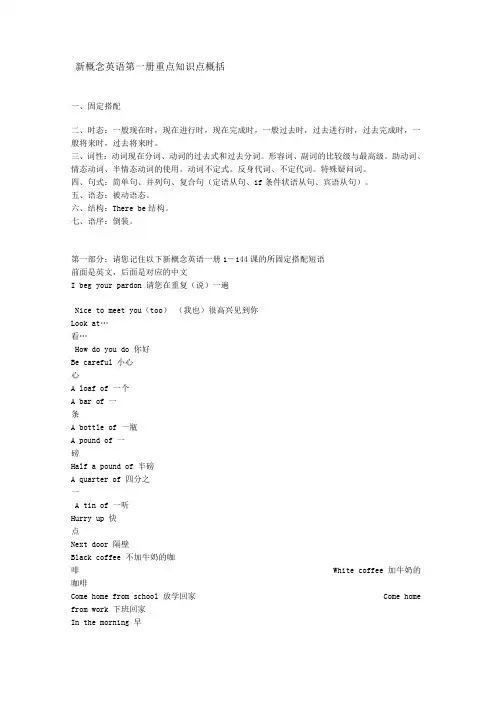
新概念英语第一册重点知识点概括一、固定搭配二、时态:一般现在时,现在进行时,现在完成时,一般过去时,过去进行时,过去完成时,一般将来时,过去将来时。
三、词性:动词现在分词、动词的过去式和过去分词。
形容词、副词的比较级与最高级。
助动词、情态动词、半情态动词的使用。
动词不定式。
反身代词、不定代词。
特殊疑问词。
四、句式:简单句、并列句、复合句(定语从句、if条件状语从句、宾语从句)。
五、语态:被动语态。
六、结构:There be结构。
七、语序:倒装。
第一部分:请您记住以下新概念英语一册1-144课的所固定搭配短语前面是英文,后面是对应的中文I beg your pardon 请您在重复(说)一遍Nice to meet you(too)(我也)很高兴见到你Look at…看…How do you do 你好Be careful 小心心A loaf of 一个A bar of 一条A bottle of 一瓶A pound of 一磅Half a pound of 半磅A quarter of 四分之一A tin of 一听Hurry up 快点Next door 隔壁Black coffee 不加牛奶的咖啡 White coffee 加牛奶的咖啡Come home from school 放学回家 Come home from work 下班回家In the morning 早上In the afternoon 下午In the evening 晚上At noon 中午At night 夜里At the moment 此刻What’s the time? 几点钟? Come upstairs 上楼Come downstairs 下楼 Hundreds of… 数以百计的…On the way home 在回家的途中 This morning 今天早晨This afternoon 今天下午 This evening 今天晚上tonight 今天夜里 Yeste rday morning 昨天早晨Yesterday afternoon 昨天下午 Yesterday evening 昨天晚上Last night 昨天夜里 The day before yesterday in the morning 前天早晨The day before yesterday in the afternoon 前天下午The day before yesterday in the evening 前天晚上The night before last 前天夜间 A low mark 分数很底A high mark 分数很高 She said to herself 她心中暗想The way to… 到…的走法 In fashion 流行的,时髦的I’m afraid… 我恐怕…I’m sure… 我确信,我肯定…A lot of 许多(用于肯定句) At all 丝毫、更本、一点也不Going on holiday 度假 Have beento… 到过…All the time 一直,始终 Drive into… 撞倒…For sale 供出售、出售 Have the last word 最后决定、最后才算The R.A.F. 英国皇家空军 Return ticket 往返票Next door to… 与…相邻,在…隔壁In five hours’time 在五小时之后。
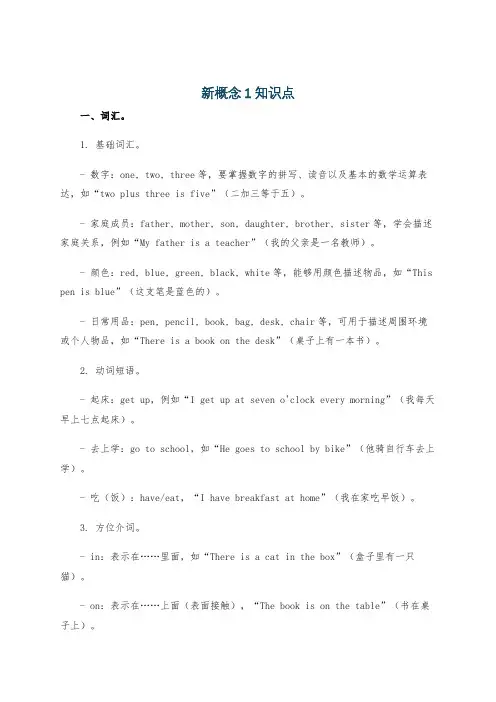
新概念1知识点一、词汇。
1. 基础词汇。
- 数字:one, two, three等,要掌握数字的拼写、读音以及基本的数学运算表达,如“two plus three is five”(二加三等于五)。
- 家庭成员:father, mother, son, daughter, brother, sister等,学会描述家庭关系,例如“My father is a teacher”(我的父亲是一名教师)。
- 颜色:red, blue, green, black, white等,能够用颜色描述物品,如“This pen is blue”(这支笔是蓝色的)。
- 日常用品:pen, pencil, book, bag, desk, chair等,可用于描述周围环境或个人物品,如“There is a book on the desk”(桌子上有一本书)。
2. 动词短语。
- 起床:get up,例如“I get up at seven o'clock every morning”(我每天早上七点起床)。
- 去上学:go to school,如“He goes to school by bike”(他骑自行车去上学)。
- 吃(饭):have/eat,“I have breakfast at home”(我在家吃早饭)。
3. 方位介词。
- in:表示在……里面,如“There is a cat in the box”(盒子里有一只猫)。
- on:表示在……上面(表面接触),“The book is on the table”(书在桌子上)。
- under:表示在……下面,“The ball is under the chair”(球在椅子下面)。
二、语法。
1. 一般现在时。
- 概念:表示经常发生的动作或存在的状态。
- 结构:- 主语是第三人称单数(he/she/it等)时,动词要加 -s或 -es。
例如“He likes reading books”(他喜欢读书)。
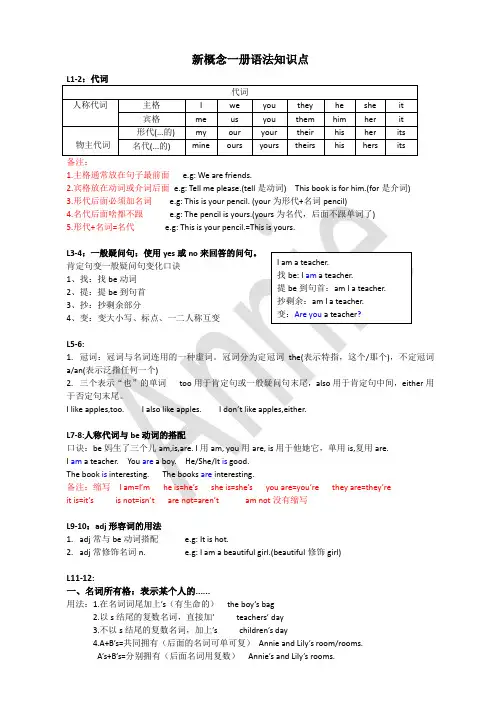
新概念一册语法知识点备注:1.主格通常放在句子最前面 e.g: We are friends.2.宾格放在动词或介词后面e.g: Tell me please.(tell是动词) This book is for him.(for是介词)3.4.5.形代+L3-41234L5-6:1.a/an(2.用L7-8:口诀:beI amThe bookit is=it’sL9-10:adj形容词的用法1.adj常与be动词搭配 e.g: It is hot.2.adj常修饰名词n. e.g: I am a beautiful girl.(beautiful修饰girl)L11-12:一、名词所有格:表示某个人的......用法:1.在名词词尾加上’s(有生命的)the boy’s bag2.以s结尾的复数名词,直接加’ teachers’ day3.不以s结尾的复数名词,加上’s children’s day4.A+B’s=共同拥有(后面的名词可单可复)Annie and Lily’s room/rooms.A’s+B’s=分别拥有(后面名词用复数)Annie’s and Lily’s rooms.二、特殊疑问词:7W1H三、对划线部分提问(特殊疑问句):想、找、抄、变L151.2.(1(2(3(4(5L171.man-men woman-women child-children mouse-mice tooth-teeth foot-feet Chinese-Chinese Japanese-Japanese sheep-sheep fish-fish deer-deer2.单数句变复数句秘诀:主语变复数,be改为are, 名词变复数,去掉a/anI am a teacher. We are teachers.L19-20:there be 句型表示某地有某物单数句There is a dog in the park.复数句There are some dogs in the park.变否定:be后加not There is not(isn’t) a dog in the park.There are not(aren’t) any dogs in the park.变疑问:be提前Is there a dog in the park? Are there any dogs in the park?备注:1.there be遵循就近原则There is a teacher and 10 students in the classroom.There are 10 students and a teacher in the classroom.2.不可数名词使用单数。
新概念英语第一册所有语法点汇总)1.一般现在时一般现在时用来表示经常性的行为、习惯、常理或客观事实。
2.一般过去时一般过去时用来表示过去一些具体时间发生的事情。
3.一般将来时一般将来时用来表示将来一些时间或状况下会发生的事情。
4.现在进行时现在进行时用来表示现在正在进行的动作或状态。
5.过去进行时过去进行时用来表示过去一些时间正在进行的动作。
6.将来进行时将来进行时用来表示将来一些时间正在进行的动作。
7. there be句型there be句型用来表示地有人或物,用来描述存在的事物。
8.一般现在时的被动语态一般现在时的被动语态用来表示事物被做或被发生。
9.一般过去时的被动语态一般过去时的被动语态用来表示过去事物被做或被发生。
10.一般将来时的被动语态一般将来时的被动语态用来表示将来事物将被做或被发生。
11.现在进行时的被动语态现在进行时的被动语态用来表示事物正在被做或被发生。
12.过去进行时的被动语态过去进行时的被动语态用来表示过去事物正在被做或被发生。
13. do与does的用法do和does用来构成否定句、疑问句和回答。
14.现在完成时现在完成时用来表示过去发生的动作对现在造成的影响或结果。
15.现在完成进行时现在完成进行时用来表示从过去开始一直延续到现在的动作,且这个动作可能还会继续下去。
16.过去完成时过去完成时用来表示过去在一些时间或事件之前已经完成的动作。
17.过去完成进行时过去完成进行时用来表示过去一些时间持续进行的动作,这个动作在另一个过去时间之前已经结束。
18.表示数量的词表示数量的词包括数词、基数词、序数词、分数和百分数等。
19.表示频率的词表示频率的词用来描述件事情发生的频率,如常常、经常、有时、很少、从不等。
20.表示时间的词表示时间的词用来描述一些事件发生的时间,如年、月、日、星期、时、分、秒等。
21.表示地点的词表示地点的词用来描述一些事件发生的地点,如国家、城市、街道、大楼等。
新概念英语一重点单词语法在新概念英语一中,重点单词和语法是学习者必须掌握的内容。
下面将详细介绍一些重点单词和语法。
一、重点单词1. 人称代词:例如I(我)、you(你)、he(他)、she(她)、it(它)等,它们用于指代不同的人或事物。
2. 动词:动词是句子的核心,表示人或事物的行为、状态或存在。
例如:work(工作)、go(去)、like(喜欢)、think(认为)等。
3. 名词:名词表示人、事物、地点等。
例如:book(书)、pen(笔)、dog(狗)等。
4. 形容词:形容词用来描述名词的特征或状态。
例如:big(大)、small(小)、happy (快乐)等。
5. 副词:副词修饰动词、形容词或其他副词,用来表示程度、方式、时间等。
例如:slowly(慢慢地)、easily(容易地)、often(经常)等。
6. 介词:介词用于连接名词、代词或动词,并在句子中显示它们之间的关系。
例如:in (在)、on(在上面)、from(从)等。
7. 冠词:冠词用于限定名词的范围。
英语中有定冠词"the"和不定冠词"a/an"。
例如:the book(这本书)、a dog(一只狗)。
8. 连词:连词用于连接单词、短语或句子,并在句子中显示它们之间的关系。
例如:and (和)、but(但是)、or(或者)等。
9. 数词:数词表示数量或顺序。
例如:one(一)、two(二)、first(第一)、second (第二)等。
10. 感叹词:感叹词用来表示强烈的情感或反应。
例如:oh(哦)、ah(啊)、wow(哇)等。
11. 代词:代词用于替代名词或名词短语,以避免重复。
例如:he(他)、she(她)、it(它)、that(那个)等。
12. 助动词:助动词用于构成疑问句、否定句、时态等。
例如:be(是)、do(做)、have(有)等。
13. 情态动词:情态动词表示可能、建议、请求等意义。
新概念第一册1-30课重点(一)复习国际音标知识(二)New words and expressions:yes; handbag; pardon; thank you/ thanks; very much; watch; coat; dress;skirt; shirt/blouse; house/horse; umbrella; please; here; ticket; number; sorry;sir/madame; suit; school; son/daughter; Mr./Mrs./Miss; new; student; French;German; Japanese; Korean; Chinese; English; American; Italian; nice; meet; make;name; nationality; job; keyboard operator; engineer; policeman; policewoman;taxi driver; air hostess; postman; nurse; mechanic; hairdresser; housewife; milkman;today; well; fine; see; fat; thin; woman; tall; short; dirty/undirty; clean; hot;cold; old; young; busy; lazy; whose; perhaps; catch; sister; brother; colour; red;green; black; white; yellow; blue; brown; grey; pink; silver; golden; orange; come;smart; upstairs/downstairs; hat; same; lovely; case; carpet; customs; office/officer;friend; passport; tourist; assistant; hard-working; child/children; tired; thirsty;sit down; right/left; ice cream; big; small; open; shut/close; light; heavy; long;shoe; give; empty; full; large; little; sharp blunt; box; glass; cup; bottle;tin; knife; fork; spoon; shelf; desk; table; plate; cupboard; cigarette; television;floor; dressing table; magazine; newspaper; stereo; kitchen; livingroom; bathroom;bedroom; garden; electric; refrigerator/bridge; cook/cooker; middle; near; window;armchair; picture; wall; trousers; must; air; put; clothes; wardrobe; dust; sweep;read; put on; take off; turn on; turn off; tree; climb; run; grass; after;across; type; letter; basket; bone; tooth; meal; drink; tap(三)、Important sentences:1. Excuse me! 在打扰别人,与陌生人搭话时客套的话。
新概念1知识点归纳总结### 一、语言基础- 词汇量:掌握基础词汇,包括日常用语、常见名词、动词、形容词等。
- 语法结构:了解基本的语法规则,如主谓宾结构、时态变化等。
### 二、句子构建- 简单句:学会构建简单句,表达清晰的意思。
- 并列句:使用并列连词连接两个或多个简单句。
### 三、时态与语态- 一般现在时:表示经常发生的动作或状态。
- 一般过去时:描述过去发生的动作或状态。
- 进行时态:表示正在进行的动作。
### 四、疑问句和否定句- 一般疑问句:通过疑问词引导,询问信息。
- 特殊疑问句:使用特殊疑问词,询问具体细节。
- 否定句:表达否定意义,使用否定词。
### 五、直接引语与间接引语- 直接引语:直接引用别人的原话。
- 间接引语:转述别人的话,使用不同的语法结构。
### 六、条件句- 真实条件句:表达真实可能发生的情况。
- 非真实条件句:表达与现实相反的假设情况。
### 七、非谓语动词- 动名词:动词+ing形式,用作名词。
- 不定式:to+动词原形,表示目的或意图。
- 分词:现在分词(-ing形式)和过去分词(-ed形式),用作形容词。
### 八、定语从句- 限制性定语从句:对先行词进行限定。
- 非限制性定语从句:对先行词进行补充说明。
### 九、状语从句- 时间状语从句:表示动作发生的时间。
- 原因状语从句:说明动作发生的原因。
- 条件状语从句:表示动作发生的条件。
### 十、虚拟语气- 对现在情况的虚拟:表示与现实相反的愿望或假设。
- 对过去情况的虚拟:表示对过去的遗憾或假设。
### 十一、文章结构- 引言:文章开头,提出主题。
- 主体:详细阐述主题,提供论据。
- 结论:文章结尾,总结全文。
### 十二、写作技巧- 段落结构:每个段落包含主题句和支持句。
- 逻辑连接:使用逻辑连接词使文章更加连贯。
通过对新概念1的知识点进行归纳总结,可以更好地掌握英语基础,为进一步学习打下坚实的基础。
新概念英语第一册知识点总结一、词汇方面。
1. 基础词汇积累。
- 包含日常生活中的各类常见名词,如“pen(钢笔)”“book(书)”“desk (书桌)”“chair(椅子)”等。
这些词汇是描述周围环境和物品的基本元素。
- 人物相关词汇,像“man(男人)”“woman(女人)”“boy(男孩)”“girl (女孩)”“teacher(教师)”“student(学生)”等,有助于构建人物关系的表达。
- 数字词汇“one(一)”“two(二)”“three(三)”……“ten(十)”等,在描述数量、排序等方面是必不可少的。
2. 近义词与反义词。
- 例如“big(大的)”和“small(小的)”是一对反义词,“tall(高的)”与“short(矮的)”也是。
近义词方面,“glad(高兴的)”和“happy(快乐的)”意思相近。
理解近义词和反义词有助于丰富词汇的使用和对比表达。
3. 词汇的复数形式。
- 一般情况直接加 -s,如“books”“pens”。
以s、x、ch、sh结尾的名词加 -es,像“boxes”“watches”。
以辅音字母 + y结尾的名词,把y变为i再加 -es,例如“baby - babies”。
特殊的复数形式如“man - men”“woman - women”“foot - feet”“tooth - teeth”等也需要牢记。
二、语法方面。
1. 一般现在时。
- 用法。
- 表示经常或习惯性的动作或状态。
例如:I get up at six every day.(我每天六点起床。
)- 表示客观事实或真理。
The earth goes around the sun.(地球绕着太阳转。
)- 句子结构。
- 主语为第三人称单数(he/she/it等)时,动词要加 -s或 -es。
如:He likes reading.(他喜欢阅读。
)- 主语为第一人称(I)、第二人称(you)以及复数主语(we/they等)时,动词用原形。
引言概述正文内容一、基本语法1. 名词:名词的单复数形式、名词所有格的表示方法以及名词的用法。
2. 冠词:冠词的三种形式(不定冠词a/an、定冠词the、零冠词)的用法和区别。
3. 代词:人称代词、形容词性物主代词、名词性物主代词、指示代词、不定代词的用法和规则。
4. 形容词和副词:形容词和副词的修饰范围、用法和变形规则。
5. 动词的形式和用法:英语动词的时态、语态、基本形式和变形规则。
二、句子结构与语法规则在这一大点中,我们将重点讨论句子的基本结构和语法规则。
具体的小点包括:1. 主谓结构:句子的基本单位,主语和谓语的搭配和一致性。
2. 系动词和表语:系动词的用法和常见的表语形式。
3. 助动词:助动词的分类和在句子中的作用。
4. 祈使句:祈使句的用法和变形规则。
5. 一般疑问句和否定句:一般疑问句和否定句的句型结构和变换规则。
三、语法练习与语境应用1. 语法练习技巧:有效地进行语法练习的方法和技巧。
2. 语境应用:根据具体的语境理解和应用语法知识。
3. 填空练习:填写合适的单词或短语来完善句子。
4. 变换句型:根据要求,改写句子的结构或用不同的句型表达相同的意思。
5. 阅读理解:通过阅读短文来理解和应用所学的语法知识。
四、词汇与词义辨析1. 常用词汇:根据不同的主题和场景,学习一些常见的单词和短语。
2. 词义辨析:学习不同词汇之间的细微差别,掌握正确使用词汇的技巧。
3. 词汇练习:通过词汇选择和搭配练习来巩固新学的词汇。
五、阅读理解和听力1. 阅读技巧:阅读理解时的注意事项和技巧。
2. 阅读理解练习:通过阅读不同主题的短文,进行理解和回答问题的练习。
3. 听力技巧:提高听力理解能力的方法和技巧。
4. 听力练习:通过听力材料,提高听力理解能力并回答问题。
总结本文总结了《新概念英语1A》中的重要知识点,包括基本语法、句子结构与语法规则、语法练习与语境应用、词汇与词义辨析以及阅读理解和听力。
通过清晰的结构和详细的内容,读者将对《新概念英语1A》的内容有一个全面的了解,并能够更好地学习和应用英语知识。
新概念英语第一册知识点归纳与讲解短语、词组归纳由动词开头构成的短语、词组很多。
复习时应分类处理:一、动词+介词1.look at…看…,look like …看上去像……, look after …照料…2.listen to…听…… 3.welcome to…欢迎到……4.say hello to …向……问好 5.speak to…对……说话此类短语相当于及物动词,其后必须带宾语,但宾语无论是名词还是代词,都要放在介词之后。
如:This is my new bike. Please look it after.(×) This is my new bike. Please look after it.(√)二、动词+副词“动词+副词”所构成的短语义分为两类:A.动词(vt.)+副词1.put on 穿上2.take off脱下3.write down记下此类短语可以带宾语,宾语若是名词,放在副词前后皆可;宾语若是人称代词,只能放在副词的前面。
试比较:First listen to the tape, then write down the answer/write the answer down. (√) First listen to the answer, then write down it.(×) First listen to the answer, then write it down.(√) B.动词(vi)+副词。
1.come on赶快2.get up起床3.go home回家4.come in进来5.sit down坐下6.stand up起立此类短语属于不及物动词,不可以带宾语。
三、其它类动词词组1.close the door2.1ook the same3.go to work/class4.be ill5.have a look/seat6.have supper7.1ook young8.go shopping9.watch TV/games 10. play games介词短语聚焦“介词+名词/代词”所构成的短语称为介词短语。
现将Unitsl-16常用的介词短语按用法进行归类。
1.in+语言/颜色/衣帽等,表示使用某种语言或穿着……。
如:in English,in the hat 2.in + Row/ Team/ Class/ Grade等,表示“在……排/队/班级/年级”等。
3.in the morning/ afternoon/ evening/ 表示“在上午/下午/傍晚”等一段时间。
4.in the desk/ pencil-box/bedroom 等表示“在书桌/铅笔盒/卧室里”。
5.in the tree表示“在树上 (非树本身所有)”;on the tree表示“在树上(为树本身所有)”。
如:There are some in the tree. There are many apples on the trees. 6.in the wall表示“在墙上(凹陷进去)”;on the wall表示“在墙上(指墙的表面)”。
如:There’re four windows in the wall, and there is a map on the back wall. 7.at work(在工作)/at school(上学)/at home(在家)应注意此类短语中无the。
8.at + 时刻表示钟点。
如:at six, at half , past ten. 9.like this/that表示方式,意为“像……这/那样”。
10.of短语表示所属关系。
如:a picture of a classroom, a map of China. 11.behind/ beside/ near/ under+ 名词等,表示方位、处所。
如:beside/ near the door, under/ behind the tree. 12.from与to多表示方向,前者意为“从……”,后者意为“到……”。
如:from one to ten, (go) to school/ bed/ work. 另外,以下这些短语也必须掌握。
如:on duty, after breakfast, at night, at the door, in the middle, in the sky, on one’s bike等。
重点句型大回放1.I think…意为“我认为……”,是对某人或某事的看法或态度的一种句型。
其否定式常用I don’t think…,如:I think he’s Mr Zhinag. (L17)I don’t think you are right. 2.give sth. to sb./ give sb. sth. 意为“把……给……”,动词give之后可接双宾语,可用这两种句型;若指物的宾语是人称代词时,则只能用giveit/ them to sb. 如:His parents give him a nice purse./His parents give a nice purse to him. Give it to Mr Hu.(L57) 3.take sb./ sth. to…意为“把……(送)带到……”,后常接地点,也可接人。
如:Please take the new books to the classroom. 4.One…, the other…/One is…and one is…意为“一个是……;另一个是……”,必须是两者中。
如:One is red and one is grey.(L50)或 One is red,, the other is grey. 5.Let sb. do sth. 意为“让某人做某事”,人后应用不带to的动词不定式,其否定式为Don’t let sb,do sth.,或Let sb. not do sth. 另外,Let’s 与Let us的含义不完全相同,前者包括听者在内,后者不包括听者在内,如:Let’s go for a walk./Let us try once more, please. 6.help sb. (to) do sth./help sb. with sth.意为“帮助某人做某事”,前者用不定式作宾补,后者用介词短语作宾补,二者可以互换。
如:Let me help you find it.(L42)/Let me help you with it. 7.What about…?/How about…?意为“……怎么样?”是用来询问或征求对方的观点、意见、看法等。
about为介词,其后须接名词、代词或V-ing等形式。
如:What/How playing chess? 8.It’s time to do…/ It’s time for sth. 意为“该做……的时间了”,其中to后须接原形动词,for后可接名词或V-ing形式。
如:It’s time to have supper. =It’s time for supper. 9.like to do sth./like doing sth.意为“喜欢做某事”,如:Li Lei and his friends like to play in the tree house. (L 43)前一种句型侧重具体的一次性的动作;后一种句型侧重习惯性的动作,试比较:Tom likes swimming, but doesn’t like to swim this afternoon. 10.ask sb.(not) to do sth. 意为“让某人(不要)做某事”,其中ask sb.后应接动词不定式,如:Ask your friends to guess what is in it. (L44)11.show sb. sth. / show sth. to do. 意为“把某物给某人看”,该句型的用法同前面第2点。
如:Show your friend your family photo.(L36)/Show your family photo to your friend. 12.introduce sb. to sb. 意为“把某人介绍给另一人”;introduce to sb.则是“向某人作介绍”。
如:Introduce your family to her.重点短语快速复习1.kinds of 各种各样的2. either…or…或者…或者…,不是…就是…3. neither…nor…既不……也不……4. Chinese tea without, anything in it 中国清茶5. take a seat 就坐6. home cooking 家常做法7. be famous for 因……而著名8. on ones way to在……途中9. be sick/ill in hospital生病住院 10. at the end of在……的尽头,在……的末尾11. wait for 等待12. in time 及时13. make one’s way to…往……(艰难地)走去14. just then 正在那时 15. first of all 首先,第一16. go wrong 走错路 17. be/get lost 迷路18. make a noise 吵闹,喧哗19. get on 上车20. get off 下车 21. stand in line 站队22. waiting room 候诊室,候车室 23. at the head of……在……的前头24. laugh at 嘲笑 25. throw about 乱丢,抛散26. in fact 实际上 27. at midnight 在半夜28. have a good time=enjoy oneself玩得愉快29. quarrel with sb. 和某人吵架 30. take one’s temperature 给某人体温31. have/get a pain in…某处疼痛 32. have a headache 头痛33. as soon as…一……就…… 34. feel like doing sth. 想要干某事35. stop…from doing sth. 阻止……干某事36. fall asleep 入睡37. again and again再三地,反复地 38. wake up 醒来,叫醒39. instead of 代替40. look over 检查41. take exercise运动42. had better(not) do sth. 最好(不要)干某事43. at the weekend 在周末44. on time 按时45. out of从……向外 46. all by oneself 独立,单独47. lots of=a lot of 许多48. no longer/more=not…any longer/more 不再49. get back 回来,取回 50. sooner or later迟早51. run away 逃跑 52. eat up 吃光,吃完53. run after 追赶 54. take sth. with sb. 某人随身带着某物55. take(good) care of…=look after…(well)(好好)照顾,照料56. think of 考虑到,想起 57. keep a diary 坚持写日记58. leave one by oneself 把某人单独留下 59. harder and harder 越来越厉害60. turn on打开(电灯、收音机、煤气等)61. turn off 关重温重点句型1.So + be/助动词/情牵动词/主语.前面陈述的肯定情况也适于另一人(物)时,常用到这种倒装结构,表示“另一人(物)也如此。